Strategic Change Management Plan using Kotter's Model
VerifiedAdded on 2021/06/17
|13
|3508
|162
Report
AI Summary
This report outlines a strategic change management plan based on John Kotter’s 8-step model, emphasizing the importance of managing change within an organization. It details strategies for increasing urgency, building a committed team, creating a clear vision, and communicating that vision effectively. The plan addresses removing obstacles, creating short-term wins, building on the change, and anchoring it within the corporate culture. The report uses Shell Company as a case study to illustrate the application of these strategies, highlighting the need for leadership commitment and addressing resistance to change. The ultimate goal is to guide organizations through transitions effectively, ensuring that changes are successfully implemented and sustained.
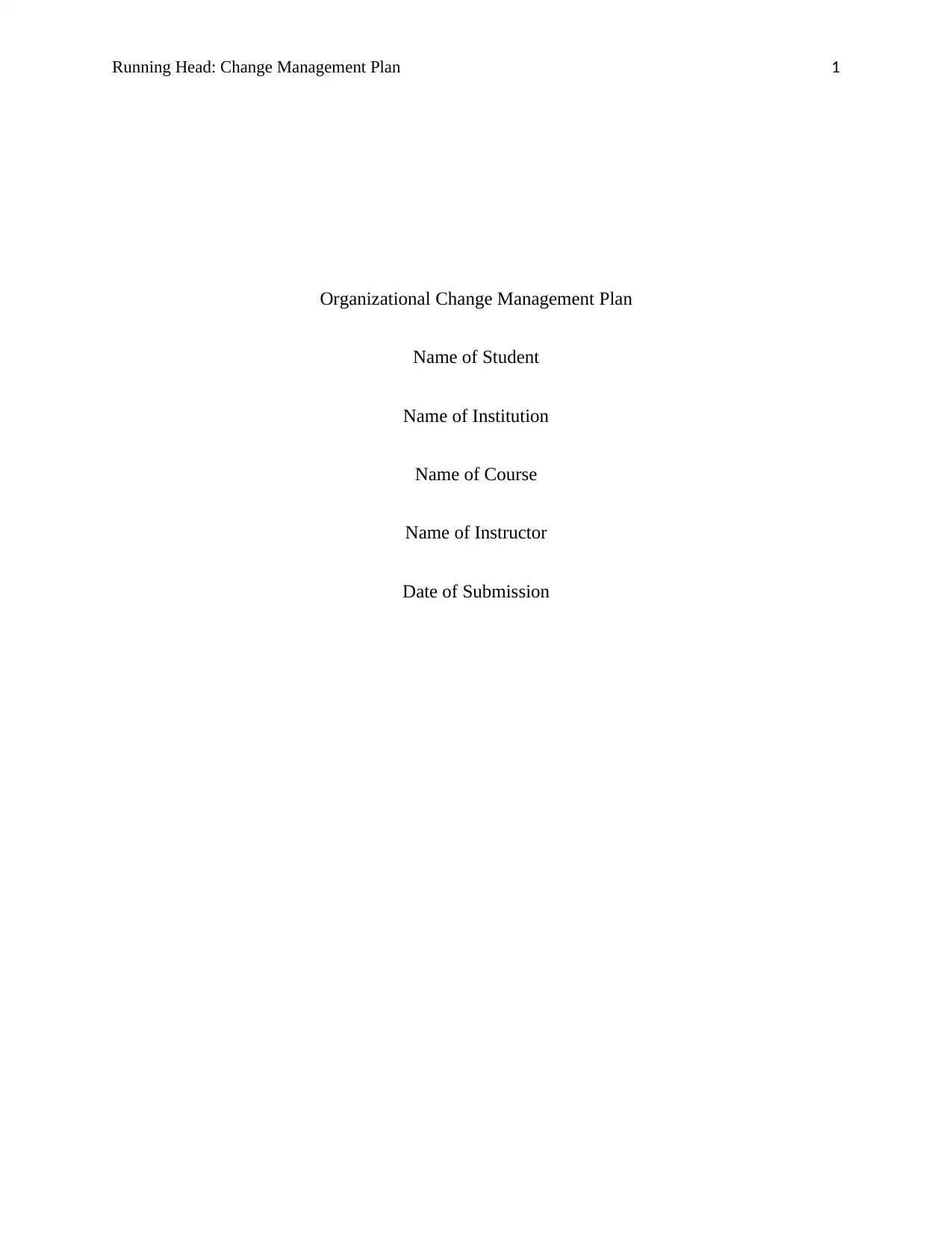
Running Head: Change Management Plan 1
Organizational Change Management Plan
Name of Student
Name of Institution
Name of Course
Name of Instructor
Date of Submission
Organizational Change Management Plan
Name of Student
Name of Institution
Name of Course
Name of Instructor
Date of Submission
Paraphrase This Document
Need a fresh take? Get an instant paraphrase of this document with our AI Paraphraser
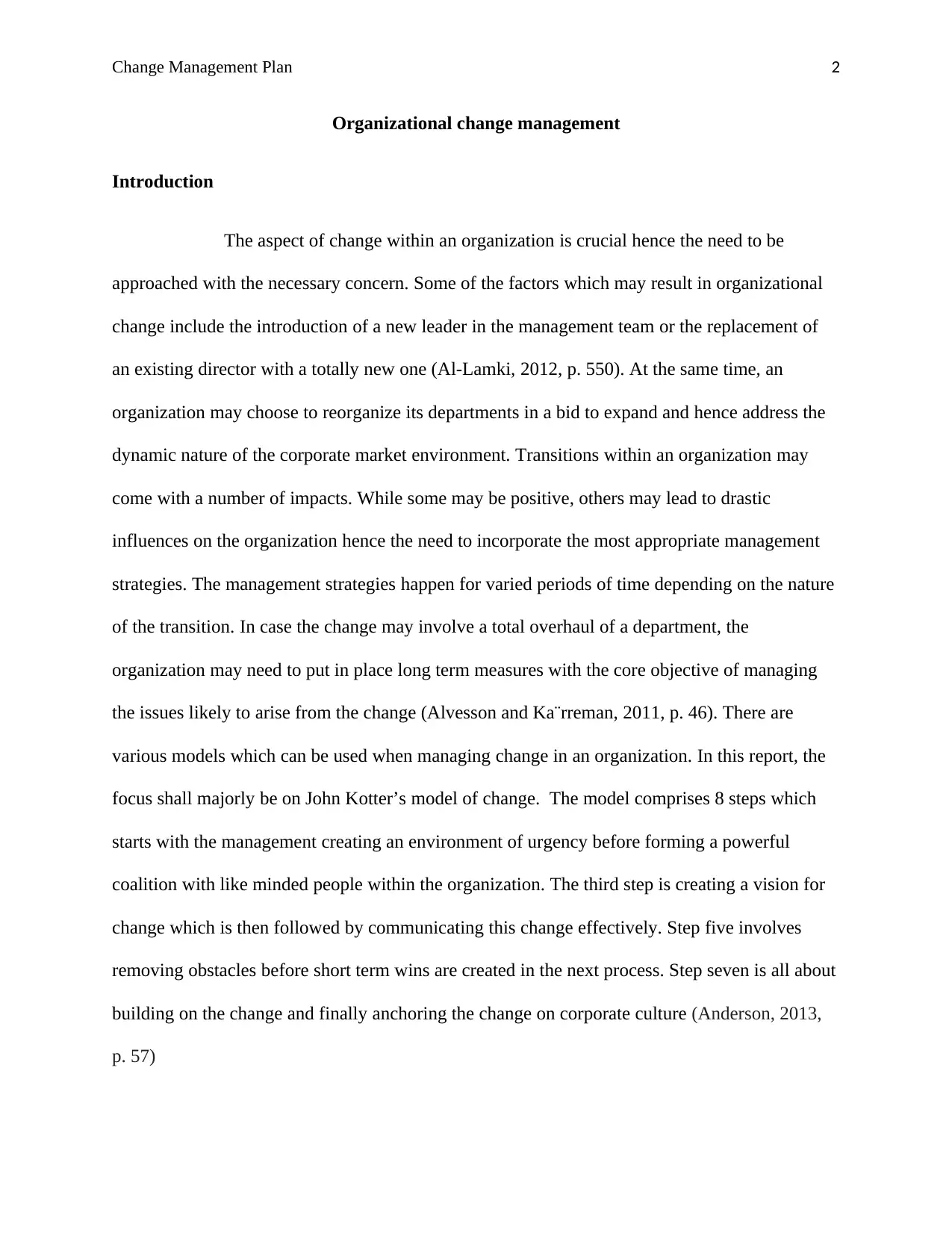
Change Management Plan 2
Organizational change management
Introduction
The aspect of change within an organization is crucial hence the need to be
approached with the necessary concern. Some of the factors which may result in organizational
change include the introduction of a new leader in the management team or the replacement of
an existing director with a totally new one (Al-Lamki, 2012, p. 550). At the same time, an
organization may choose to reorganize its departments in a bid to expand and hence address the
dynamic nature of the corporate market environment. Transitions within an organization may
come with a number of impacts. While some may be positive, others may lead to drastic
influences on the organization hence the need to incorporate the most appropriate management
strategies. The management strategies happen for varied periods of time depending on the nature
of the transition. In case the change may involve a total overhaul of a department, the
organization may need to put in place long term measures with the core objective of managing
the issues likely to arise from the change (Alvesson and Ka¨rreman, 2011, p. 46). There are
various models which can be used when managing change in an organization. In this report, the
focus shall majorly be on John Kotter’s model of change. The model comprises 8 steps which
starts with the management creating an environment of urgency before forming a powerful
coalition with like minded people within the organization. The third step is creating a vision for
change which is then followed by communicating this change effectively. Step five involves
removing obstacles before short term wins are created in the next process. Step seven is all about
building on the change and finally anchoring the change on corporate culture (Anderson, 2013,
p. 57)
Organizational change management
Introduction
The aspect of change within an organization is crucial hence the need to be
approached with the necessary concern. Some of the factors which may result in organizational
change include the introduction of a new leader in the management team or the replacement of
an existing director with a totally new one (Al-Lamki, 2012, p. 550). At the same time, an
organization may choose to reorganize its departments in a bid to expand and hence address the
dynamic nature of the corporate market environment. Transitions within an organization may
come with a number of impacts. While some may be positive, others may lead to drastic
influences on the organization hence the need to incorporate the most appropriate management
strategies. The management strategies happen for varied periods of time depending on the nature
of the transition. In case the change may involve a total overhaul of a department, the
organization may need to put in place long term measures with the core objective of managing
the issues likely to arise from the change (Alvesson and Ka¨rreman, 2011, p. 46). There are
various models which can be used when managing change in an organization. In this report, the
focus shall majorly be on John Kotter’s model of change. The model comprises 8 steps which
starts with the management creating an environment of urgency before forming a powerful
coalition with like minded people within the organization. The third step is creating a vision for
change which is then followed by communicating this change effectively. Step five involves
removing obstacles before short term wins are created in the next process. Step seven is all about
building on the change and finally anchoring the change on corporate culture (Anderson, 2013,
p. 57)
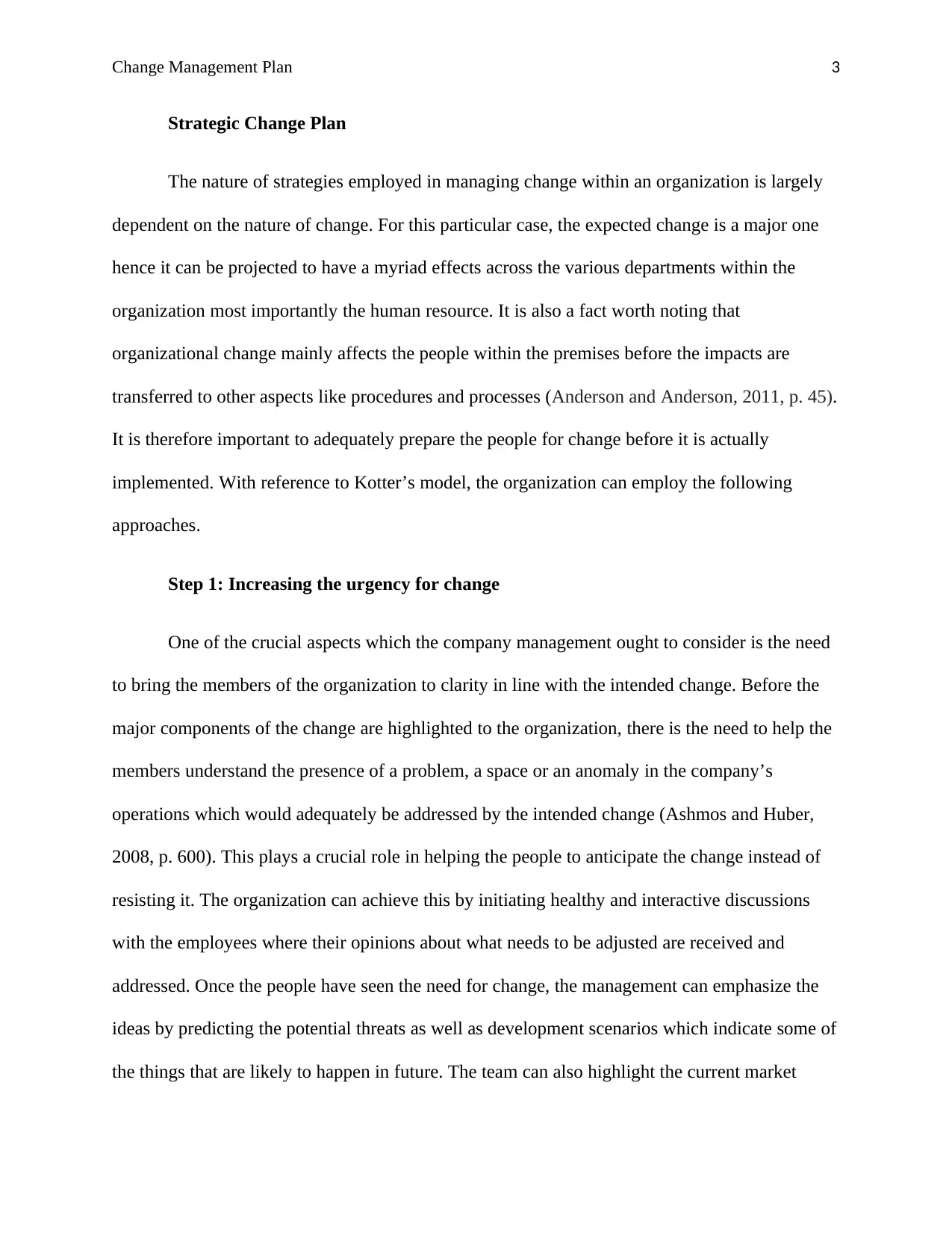
Change Management Plan 3
Strategic Change Plan
The nature of strategies employed in managing change within an organization is largely
dependent on the nature of change. For this particular case, the expected change is a major one
hence it can be projected to have a myriad effects across the various departments within the
organization most importantly the human resource. It is also a fact worth noting that
organizational change mainly affects the people within the premises before the impacts are
transferred to other aspects like procedures and processes (Anderson and Anderson, 2011, p. 45).
It is therefore important to adequately prepare the people for change before it is actually
implemented. With reference to Kotter’s model, the organization can employ the following
approaches.
Step 1: Increasing the urgency for change
One of the crucial aspects which the company management ought to consider is the need
to bring the members of the organization to clarity in line with the intended change. Before the
major components of the change are highlighted to the organization, there is the need to help the
members understand the presence of a problem, a space or an anomaly in the company’s
operations which would adequately be addressed by the intended change (Ashmos and Huber,
2008, p. 600). This plays a crucial role in helping the people to anticipate the change instead of
resisting it. The organization can achieve this by initiating healthy and interactive discussions
with the employees where their opinions about what needs to be adjusted are received and
addressed. Once the people have seen the need for change, the management can emphasize the
ideas by predicting the potential threats as well as development scenarios which indicate some of
the things that are likely to happen in future. The team can also highlight the current market
Strategic Change Plan
The nature of strategies employed in managing change within an organization is largely
dependent on the nature of change. For this particular case, the expected change is a major one
hence it can be projected to have a myriad effects across the various departments within the
organization most importantly the human resource. It is also a fact worth noting that
organizational change mainly affects the people within the premises before the impacts are
transferred to other aspects like procedures and processes (Anderson and Anderson, 2011, p. 45).
It is therefore important to adequately prepare the people for change before it is actually
implemented. With reference to Kotter’s model, the organization can employ the following
approaches.
Step 1: Increasing the urgency for change
One of the crucial aspects which the company management ought to consider is the need
to bring the members of the organization to clarity in line with the intended change. Before the
major components of the change are highlighted to the organization, there is the need to help the
members understand the presence of a problem, a space or an anomaly in the company’s
operations which would adequately be addressed by the intended change (Ashmos and Huber,
2008, p. 600). This plays a crucial role in helping the people to anticipate the change instead of
resisting it. The organization can achieve this by initiating healthy and interactive discussions
with the employees where their opinions about what needs to be adjusted are received and
addressed. Once the people have seen the need for change, the management can emphasize the
ideas by predicting the potential threats as well as development scenarios which indicate some of
the things that are likely to happen in future. The team can also highlight the current market
⊘ This is a preview!⊘
Do you want full access?
Subscribe today to unlock all pages.

Trusted by 1+ million students worldwide
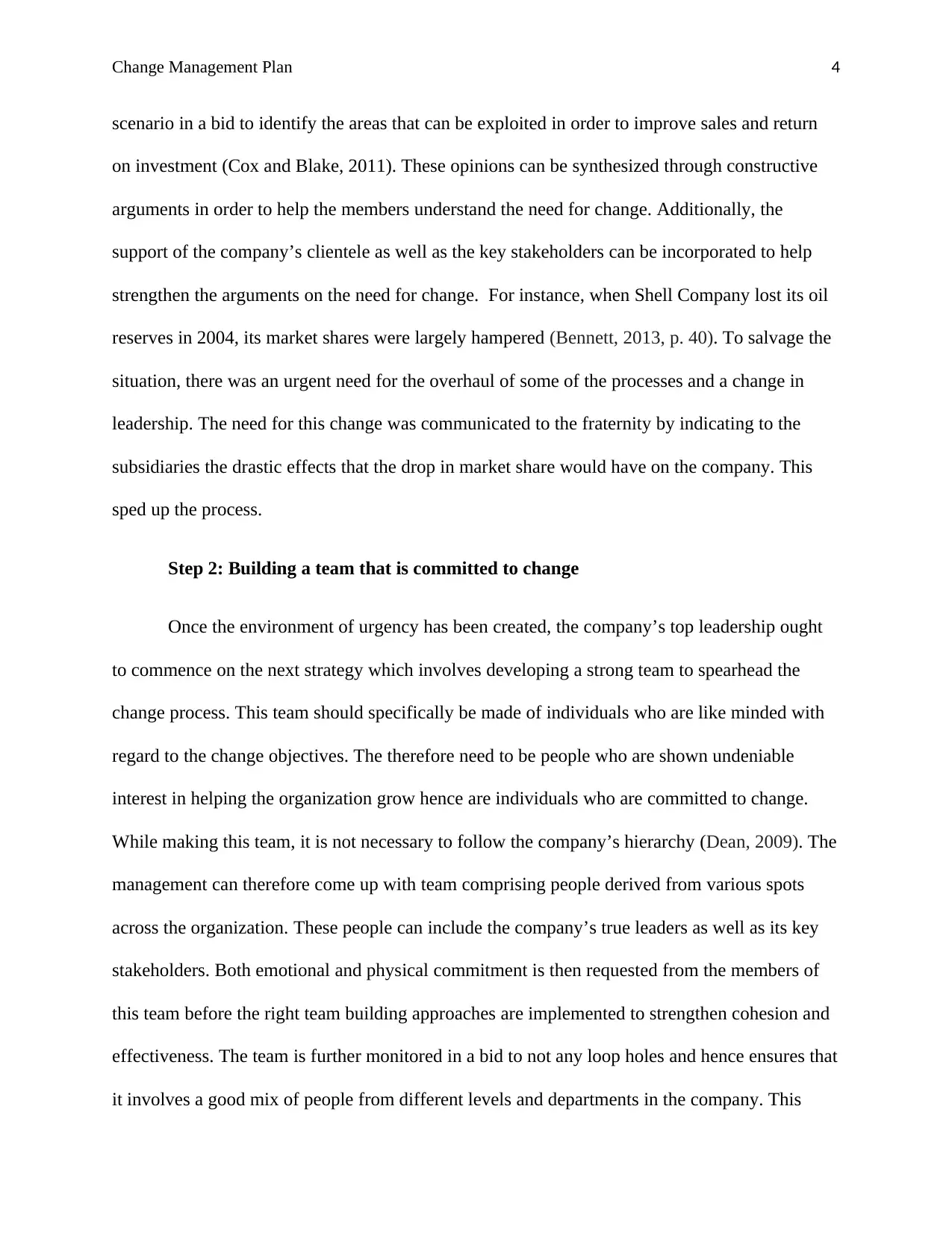
Change Management Plan 4
scenario in a bid to identify the areas that can be exploited in order to improve sales and return
on investment (Cox and Blake, 2011). These opinions can be synthesized through constructive
arguments in order to help the members understand the need for change. Additionally, the
support of the company’s clientele as well as the key stakeholders can be incorporated to help
strengthen the arguments on the need for change. For instance, when Shell Company lost its oil
reserves in 2004, its market shares were largely hampered (Bennett, 2013, p. 40). To salvage the
situation, there was an urgent need for the overhaul of some of the processes and a change in
leadership. The need for this change was communicated to the fraternity by indicating to the
subsidiaries the drastic effects that the drop in market share would have on the company. This
sped up the process.
Step 2: Building a team that is committed to change
Once the environment of urgency has been created, the company’s top leadership ought
to commence on the next strategy which involves developing a strong team to spearhead the
change process. This team should specifically be made of individuals who are like minded with
regard to the change objectives. The therefore need to be people who are shown undeniable
interest in helping the organization grow hence are individuals who are committed to change.
While making this team, it is not necessary to follow the company’s hierarchy (Dean, 2009). The
management can therefore come up with team comprising people derived from various spots
across the organization. These people can include the company’s true leaders as well as its key
stakeholders. Both emotional and physical commitment is then requested from the members of
this team before the right team building approaches are implemented to strengthen cohesion and
effectiveness. The team is further monitored in a bid to not any loop holes and hence ensures that
it involves a good mix of people from different levels and departments in the company. This
scenario in a bid to identify the areas that can be exploited in order to improve sales and return
on investment (Cox and Blake, 2011). These opinions can be synthesized through constructive
arguments in order to help the members understand the need for change. Additionally, the
support of the company’s clientele as well as the key stakeholders can be incorporated to help
strengthen the arguments on the need for change. For instance, when Shell Company lost its oil
reserves in 2004, its market shares were largely hampered (Bennett, 2013, p. 40). To salvage the
situation, there was an urgent need for the overhaul of some of the processes and a change in
leadership. The need for this change was communicated to the fraternity by indicating to the
subsidiaries the drastic effects that the drop in market share would have on the company. This
sped up the process.
Step 2: Building a team that is committed to change
Once the environment of urgency has been created, the company’s top leadership ought
to commence on the next strategy which involves developing a strong team to spearhead the
change process. This team should specifically be made of individuals who are like minded with
regard to the change objectives. The therefore need to be people who are shown undeniable
interest in helping the organization grow hence are individuals who are committed to change.
While making this team, it is not necessary to follow the company’s hierarchy (Dean, 2009). The
management can therefore come up with team comprising people derived from various spots
across the organization. These people can include the company’s true leaders as well as its key
stakeholders. Both emotional and physical commitment is then requested from the members of
this team before the right team building approaches are implemented to strengthen cohesion and
effectiveness. The team is further monitored in a bid to not any loop holes and hence ensures that
it involves a good mix of people from different levels and departments in the company. This
Paraphrase This Document
Need a fresh take? Get an instant paraphrase of this document with our AI Paraphraser
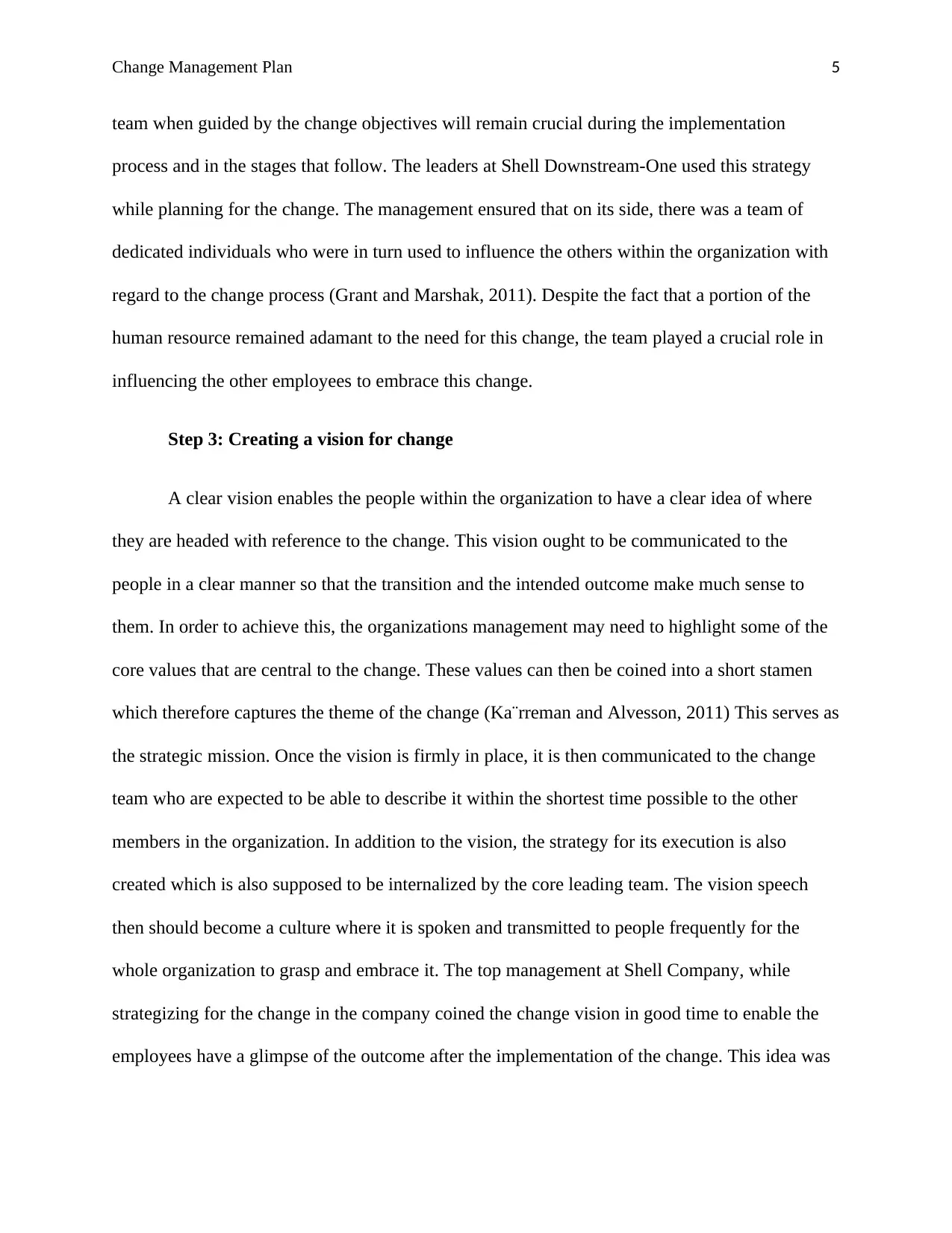
Change Management Plan 5
team when guided by the change objectives will remain crucial during the implementation
process and in the stages that follow. The leaders at Shell Downstream-One used this strategy
while planning for the change. The management ensured that on its side, there was a team of
dedicated individuals who were in turn used to influence the others within the organization with
regard to the change process (Grant and Marshak, 2011). Despite the fact that a portion of the
human resource remained adamant to the need for this change, the team played a crucial role in
influencing the other employees to embrace this change.
Step 3: Creating a vision for change
A clear vision enables the people within the organization to have a clear idea of where
they are headed with reference to the change. This vision ought to be communicated to the
people in a clear manner so that the transition and the intended outcome make much sense to
them. In order to achieve this, the organizations management may need to highlight some of the
core values that are central to the change. These values can then be coined into a short stamen
which therefore captures the theme of the change (Ka¨rreman and Alvesson, 2011) This serves as
the strategic mission. Once the vision is firmly in place, it is then communicated to the change
team who are expected to be able to describe it within the shortest time possible to the other
members in the organization. In addition to the vision, the strategy for its execution is also
created which is also supposed to be internalized by the core leading team. The vision speech
then should become a culture where it is spoken and transmitted to people frequently for the
whole organization to grasp and embrace it. The top management at Shell Company, while
strategizing for the change in the company coined the change vision in good time to enable the
employees have a glimpse of the outcome after the implementation of the change. This idea was
team when guided by the change objectives will remain crucial during the implementation
process and in the stages that follow. The leaders at Shell Downstream-One used this strategy
while planning for the change. The management ensured that on its side, there was a team of
dedicated individuals who were in turn used to influence the others within the organization with
regard to the change process (Grant and Marshak, 2011). Despite the fact that a portion of the
human resource remained adamant to the need for this change, the team played a crucial role in
influencing the other employees to embrace this change.
Step 3: Creating a vision for change
A clear vision enables the people within the organization to have a clear idea of where
they are headed with reference to the change. This vision ought to be communicated to the
people in a clear manner so that the transition and the intended outcome make much sense to
them. In order to achieve this, the organizations management may need to highlight some of the
core values that are central to the change. These values can then be coined into a short stamen
which therefore captures the theme of the change (Ka¨rreman and Alvesson, 2011) This serves as
the strategic mission. Once the vision is firmly in place, it is then communicated to the change
team who are expected to be able to describe it within the shortest time possible to the other
members in the organization. In addition to the vision, the strategy for its execution is also
created which is also supposed to be internalized by the core leading team. The vision speech
then should become a culture where it is spoken and transmitted to people frequently for the
whole organization to grasp and embrace it. The top management at Shell Company, while
strategizing for the change in the company coined the change vision in good time to enable the
employees have a glimpse of the outcome after the implementation of the change. This idea was
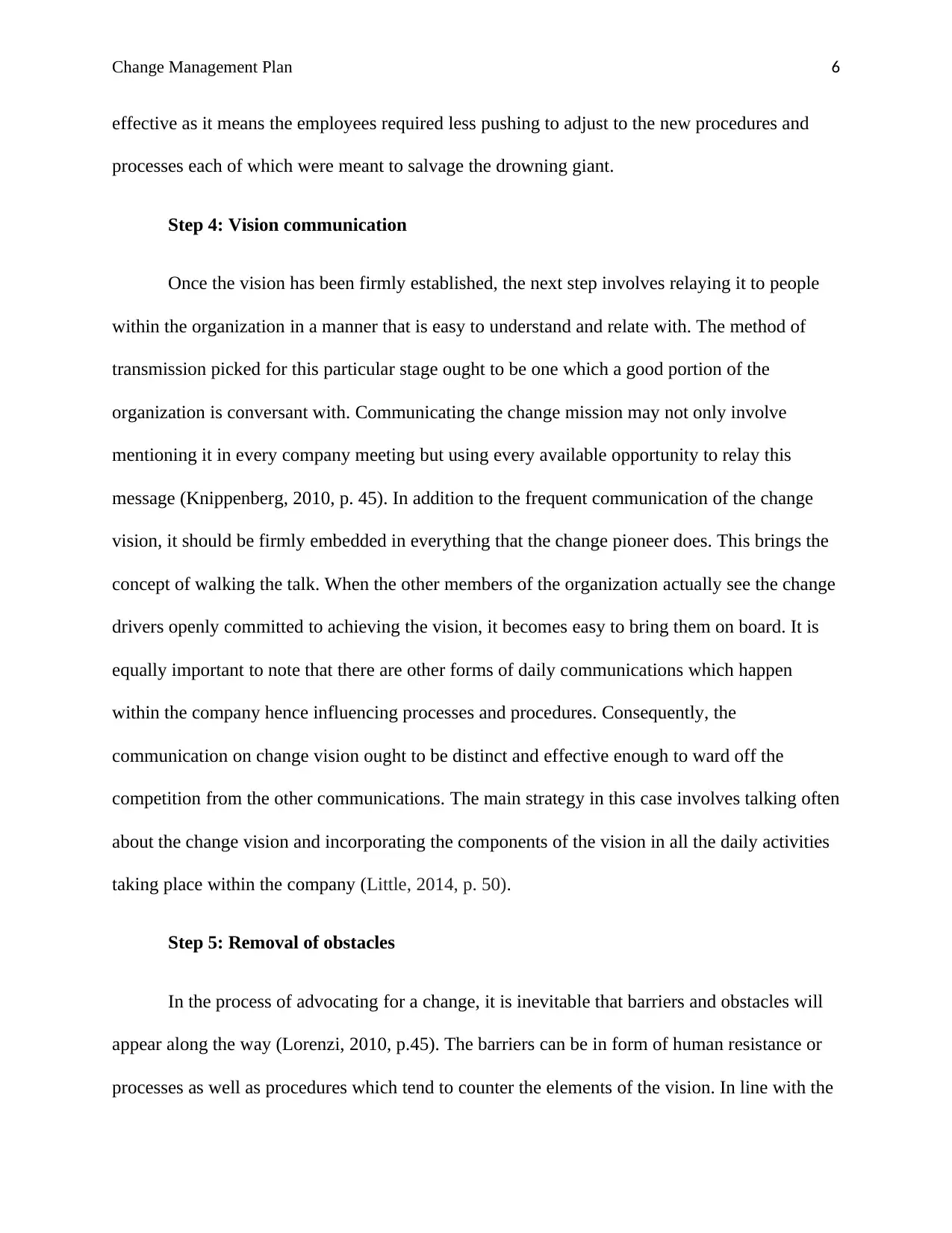
Change Management Plan 6
effective as it means the employees required less pushing to adjust to the new procedures and
processes each of which were meant to salvage the drowning giant.
Step 4: Vision communication
Once the vision has been firmly established, the next step involves relaying it to people
within the organization in a manner that is easy to understand and relate with. The method of
transmission picked for this particular stage ought to be one which a good portion of the
organization is conversant with. Communicating the change mission may not only involve
mentioning it in every company meeting but using every available opportunity to relay this
message (Knippenberg, 2010, p. 45). In addition to the frequent communication of the change
vision, it should be firmly embedded in everything that the change pioneer does. This brings the
concept of walking the talk. When the other members of the organization actually see the change
drivers openly committed to achieving the vision, it becomes easy to bring them on board. It is
equally important to note that there are other forms of daily communications which happen
within the company hence influencing processes and procedures. Consequently, the
communication on change vision ought to be distinct and effective enough to ward off the
competition from the other communications. The main strategy in this case involves talking often
about the change vision and incorporating the components of the vision in all the daily activities
taking place within the company (Little, 2014, p. 50).
Step 5: Removal of obstacles
In the process of advocating for a change, it is inevitable that barriers and obstacles will
appear along the way (Lorenzi, 2010, p.45). The barriers can be in form of human resistance or
processes as well as procedures which tend to counter the elements of the vision. In line with the
effective as it means the employees required less pushing to adjust to the new procedures and
processes each of which were meant to salvage the drowning giant.
Step 4: Vision communication
Once the vision has been firmly established, the next step involves relaying it to people
within the organization in a manner that is easy to understand and relate with. The method of
transmission picked for this particular stage ought to be one which a good portion of the
organization is conversant with. Communicating the change mission may not only involve
mentioning it in every company meeting but using every available opportunity to relay this
message (Knippenberg, 2010, p. 45). In addition to the frequent communication of the change
vision, it should be firmly embedded in everything that the change pioneer does. This brings the
concept of walking the talk. When the other members of the organization actually see the change
drivers openly committed to achieving the vision, it becomes easy to bring them on board. It is
equally important to note that there are other forms of daily communications which happen
within the company hence influencing processes and procedures. Consequently, the
communication on change vision ought to be distinct and effective enough to ward off the
competition from the other communications. The main strategy in this case involves talking often
about the change vision and incorporating the components of the vision in all the daily activities
taking place within the company (Little, 2014, p. 50).
Step 5: Removal of obstacles
In the process of advocating for a change, it is inevitable that barriers and obstacles will
appear along the way (Lorenzi, 2010, p.45). The barriers can be in form of human resistance or
processes as well as procedures which tend to counter the elements of the vision. In line with the
⊘ This is a preview!⊘
Do you want full access?
Subscribe today to unlock all pages.

Trusted by 1+ million students worldwide
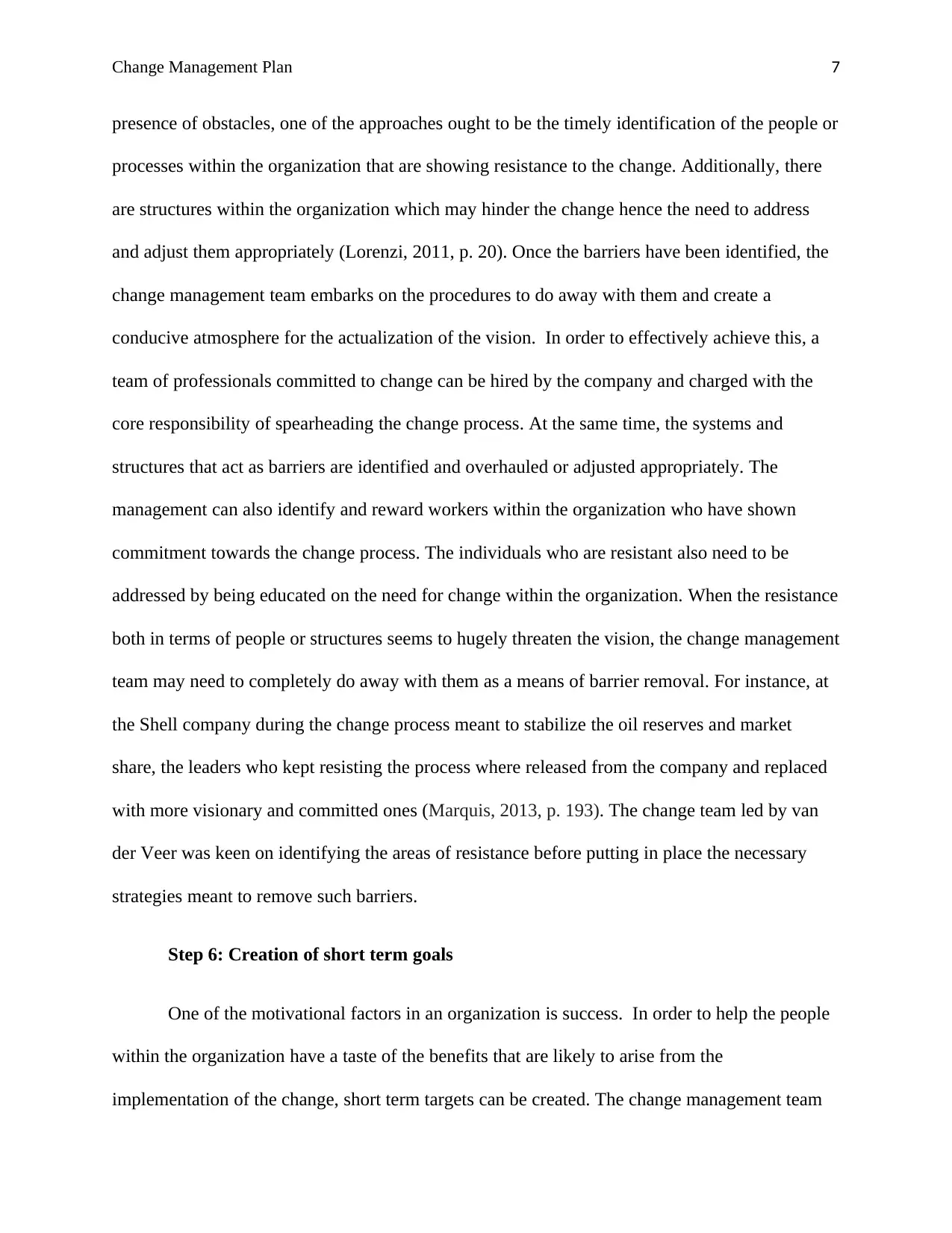
Change Management Plan 7
presence of obstacles, one of the approaches ought to be the timely identification of the people or
processes within the organization that are showing resistance to the change. Additionally, there
are structures within the organization which may hinder the change hence the need to address
and adjust them appropriately (Lorenzi, 2011, p. 20). Once the barriers have been identified, the
change management team embarks on the procedures to do away with them and create a
conducive atmosphere for the actualization of the vision. In order to effectively achieve this, a
team of professionals committed to change can be hired by the company and charged with the
core responsibility of spearheading the change process. At the same time, the systems and
structures that act as barriers are identified and overhauled or adjusted appropriately. The
management can also identify and reward workers within the organization who have shown
commitment towards the change process. The individuals who are resistant also need to be
addressed by being educated on the need for change within the organization. When the resistance
both in terms of people or structures seems to hugely threaten the vision, the change management
team may need to completely do away with them as a means of barrier removal. For instance, at
the Shell company during the change process meant to stabilize the oil reserves and market
share, the leaders who kept resisting the process where released from the company and replaced
with more visionary and committed ones (Marquis, 2013, p. 193). The change team led by van
der Veer was keen on identifying the areas of resistance before putting in place the necessary
strategies meant to remove such barriers.
Step 6: Creation of short term goals
One of the motivational factors in an organization is success. In order to help the people
within the organization have a taste of the benefits that are likely to arise from the
implementation of the change, short term targets can be created. The change management team
presence of obstacles, one of the approaches ought to be the timely identification of the people or
processes within the organization that are showing resistance to the change. Additionally, there
are structures within the organization which may hinder the change hence the need to address
and adjust them appropriately (Lorenzi, 2011, p. 20). Once the barriers have been identified, the
change management team embarks on the procedures to do away with them and create a
conducive atmosphere for the actualization of the vision. In order to effectively achieve this, a
team of professionals committed to change can be hired by the company and charged with the
core responsibility of spearheading the change process. At the same time, the systems and
structures that act as barriers are identified and overhauled or adjusted appropriately. The
management can also identify and reward workers within the organization who have shown
commitment towards the change process. The individuals who are resistant also need to be
addressed by being educated on the need for change within the organization. When the resistance
both in terms of people or structures seems to hugely threaten the vision, the change management
team may need to completely do away with them as a means of barrier removal. For instance, at
the Shell company during the change process meant to stabilize the oil reserves and market
share, the leaders who kept resisting the process where released from the company and replaced
with more visionary and committed ones (Marquis, 2013, p. 193). The change team led by van
der Veer was keen on identifying the areas of resistance before putting in place the necessary
strategies meant to remove such barriers.
Step 6: Creation of short term goals
One of the motivational factors in an organization is success. In order to help the people
within the organization have a taste of the benefits that are likely to arise from the
implementation of the change, short term targets can be created. The change management team
Paraphrase This Document
Need a fresh take? Get an instant paraphrase of this document with our AI Paraphraser
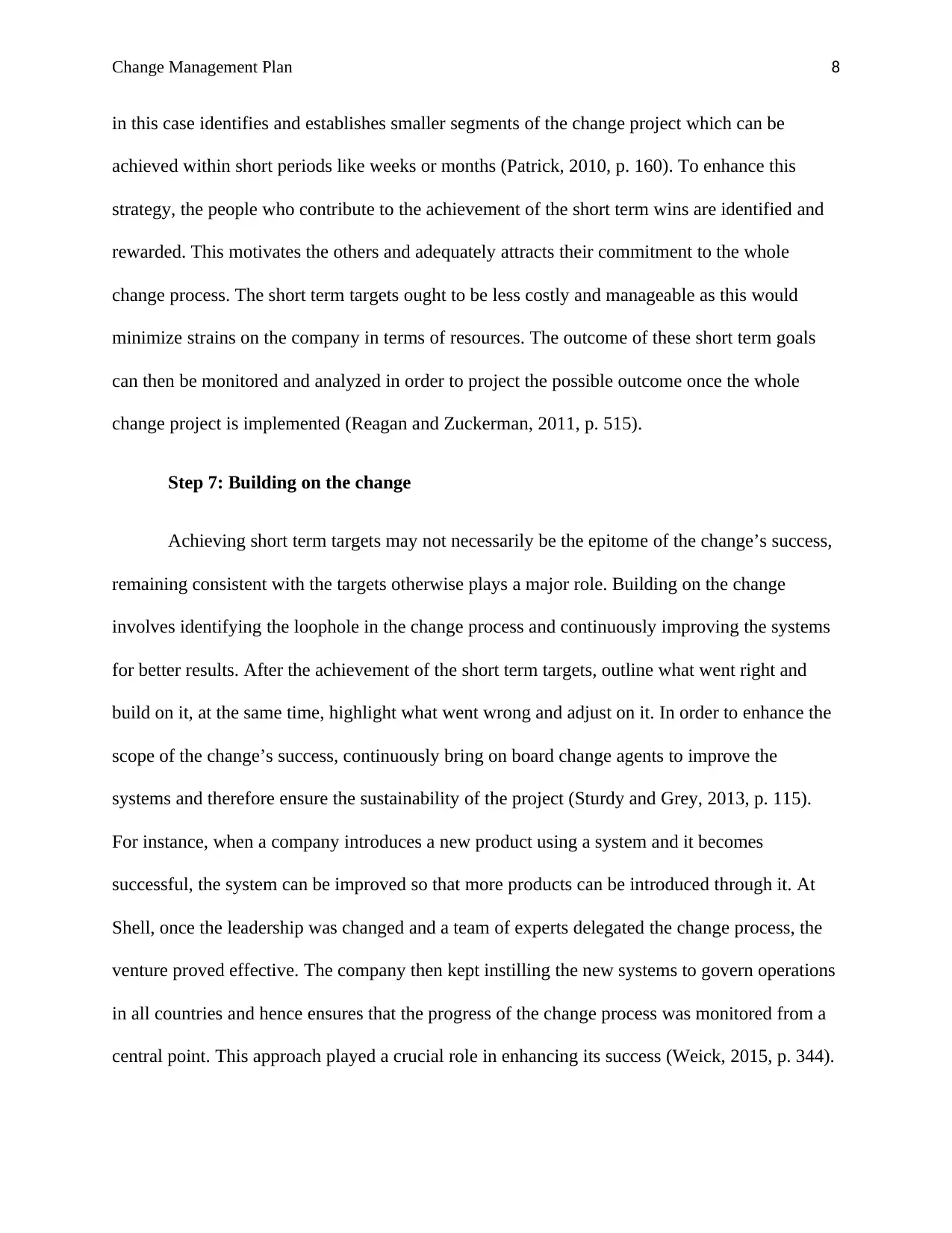
Change Management Plan 8
in this case identifies and establishes smaller segments of the change project which can be
achieved within short periods like weeks or months (Patrick, 2010, p. 160). To enhance this
strategy, the people who contribute to the achievement of the short term wins are identified and
rewarded. This motivates the others and adequately attracts their commitment to the whole
change process. The short term targets ought to be less costly and manageable as this would
minimize strains on the company in terms of resources. The outcome of these short term goals
can then be monitored and analyzed in order to project the possible outcome once the whole
change project is implemented (Reagan and Zuckerman, 2011, p. 515).
Step 7: Building on the change
Achieving short term targets may not necessarily be the epitome of the change’s success,
remaining consistent with the targets otherwise plays a major role. Building on the change
involves identifying the loophole in the change process and continuously improving the systems
for better results. After the achievement of the short term targets, outline what went right and
build on it, at the same time, highlight what went wrong and adjust on it. In order to enhance the
scope of the change’s success, continuously bring on board change agents to improve the
systems and therefore ensure the sustainability of the project (Sturdy and Grey, 2013, p. 115).
For instance, when a company introduces a new product using a system and it becomes
successful, the system can be improved so that more products can be introduced through it. At
Shell, once the leadership was changed and a team of experts delegated the change process, the
venture proved effective. The company then kept instilling the new systems to govern operations
in all countries and hence ensures that the progress of the change process was monitored from a
central point. This approach played a crucial role in enhancing its success (Weick, 2015, p. 344).
in this case identifies and establishes smaller segments of the change project which can be
achieved within short periods like weeks or months (Patrick, 2010, p. 160). To enhance this
strategy, the people who contribute to the achievement of the short term wins are identified and
rewarded. This motivates the others and adequately attracts their commitment to the whole
change process. The short term targets ought to be less costly and manageable as this would
minimize strains on the company in terms of resources. The outcome of these short term goals
can then be monitored and analyzed in order to project the possible outcome once the whole
change project is implemented (Reagan and Zuckerman, 2011, p. 515).
Step 7: Building on the change
Achieving short term targets may not necessarily be the epitome of the change’s success,
remaining consistent with the targets otherwise plays a major role. Building on the change
involves identifying the loophole in the change process and continuously improving the systems
for better results. After the achievement of the short term targets, outline what went right and
build on it, at the same time, highlight what went wrong and adjust on it. In order to enhance the
scope of the change’s success, continuously bring on board change agents to improve the
systems and therefore ensure the sustainability of the project (Sturdy and Grey, 2013, p. 115).
For instance, when a company introduces a new product using a system and it becomes
successful, the system can be improved so that more products can be introduced through it. At
Shell, once the leadership was changed and a team of experts delegated the change process, the
venture proved effective. The company then kept instilling the new systems to govern operations
in all countries and hence ensures that the progress of the change process was monitored from a
central point. This approach played a crucial role in enhancing its success (Weick, 2015, p. 344).
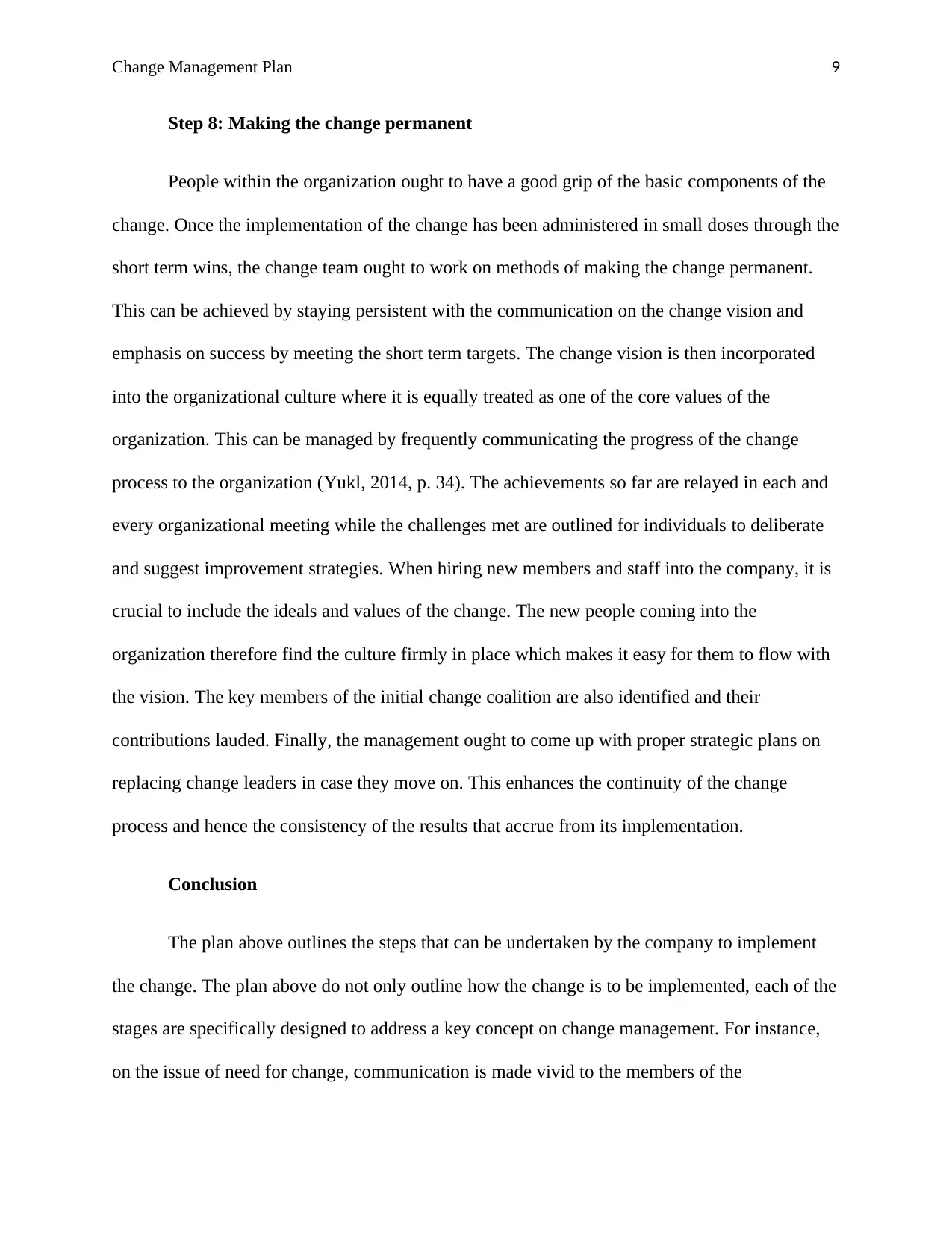
Change Management Plan 9
Step 8: Making the change permanent
People within the organization ought to have a good grip of the basic components of the
change. Once the implementation of the change has been administered in small doses through the
short term wins, the change team ought to work on methods of making the change permanent.
This can be achieved by staying persistent with the communication on the change vision and
emphasis on success by meeting the short term targets. The change vision is then incorporated
into the organizational culture where it is equally treated as one of the core values of the
organization. This can be managed by frequently communicating the progress of the change
process to the organization (Yukl, 2014, p. 34). The achievements so far are relayed in each and
every organizational meeting while the challenges met are outlined for individuals to deliberate
and suggest improvement strategies. When hiring new members and staff into the company, it is
crucial to include the ideals and values of the change. The new people coming into the
organization therefore find the culture firmly in place which makes it easy for them to flow with
the vision. The key members of the initial change coalition are also identified and their
contributions lauded. Finally, the management ought to come up with proper strategic plans on
replacing change leaders in case they move on. This enhances the continuity of the change
process and hence the consistency of the results that accrue from its implementation.
Conclusion
The plan above outlines the steps that can be undertaken by the company to implement
the change. The plan above do not only outline how the change is to be implemented, each of the
stages are specifically designed to address a key concept on change management. For instance,
on the issue of need for change, communication is made vivid to the members of the
Step 8: Making the change permanent
People within the organization ought to have a good grip of the basic components of the
change. Once the implementation of the change has been administered in small doses through the
short term wins, the change team ought to work on methods of making the change permanent.
This can be achieved by staying persistent with the communication on the change vision and
emphasis on success by meeting the short term targets. The change vision is then incorporated
into the organizational culture where it is equally treated as one of the core values of the
organization. This can be managed by frequently communicating the progress of the change
process to the organization (Yukl, 2014, p. 34). The achievements so far are relayed in each and
every organizational meeting while the challenges met are outlined for individuals to deliberate
and suggest improvement strategies. When hiring new members and staff into the company, it is
crucial to include the ideals and values of the change. The new people coming into the
organization therefore find the culture firmly in place which makes it easy for them to flow with
the vision. The key members of the initial change coalition are also identified and their
contributions lauded. Finally, the management ought to come up with proper strategic plans on
replacing change leaders in case they move on. This enhances the continuity of the change
process and hence the consistency of the results that accrue from its implementation.
Conclusion
The plan above outlines the steps that can be undertaken by the company to implement
the change. The plan above do not only outline how the change is to be implemented, each of the
stages are specifically designed to address a key concept on change management. For instance,
on the issue of need for change, communication is made vivid to the members of the
⊘ This is a preview!⊘
Do you want full access?
Subscribe today to unlock all pages.

Trusted by 1+ million students worldwide
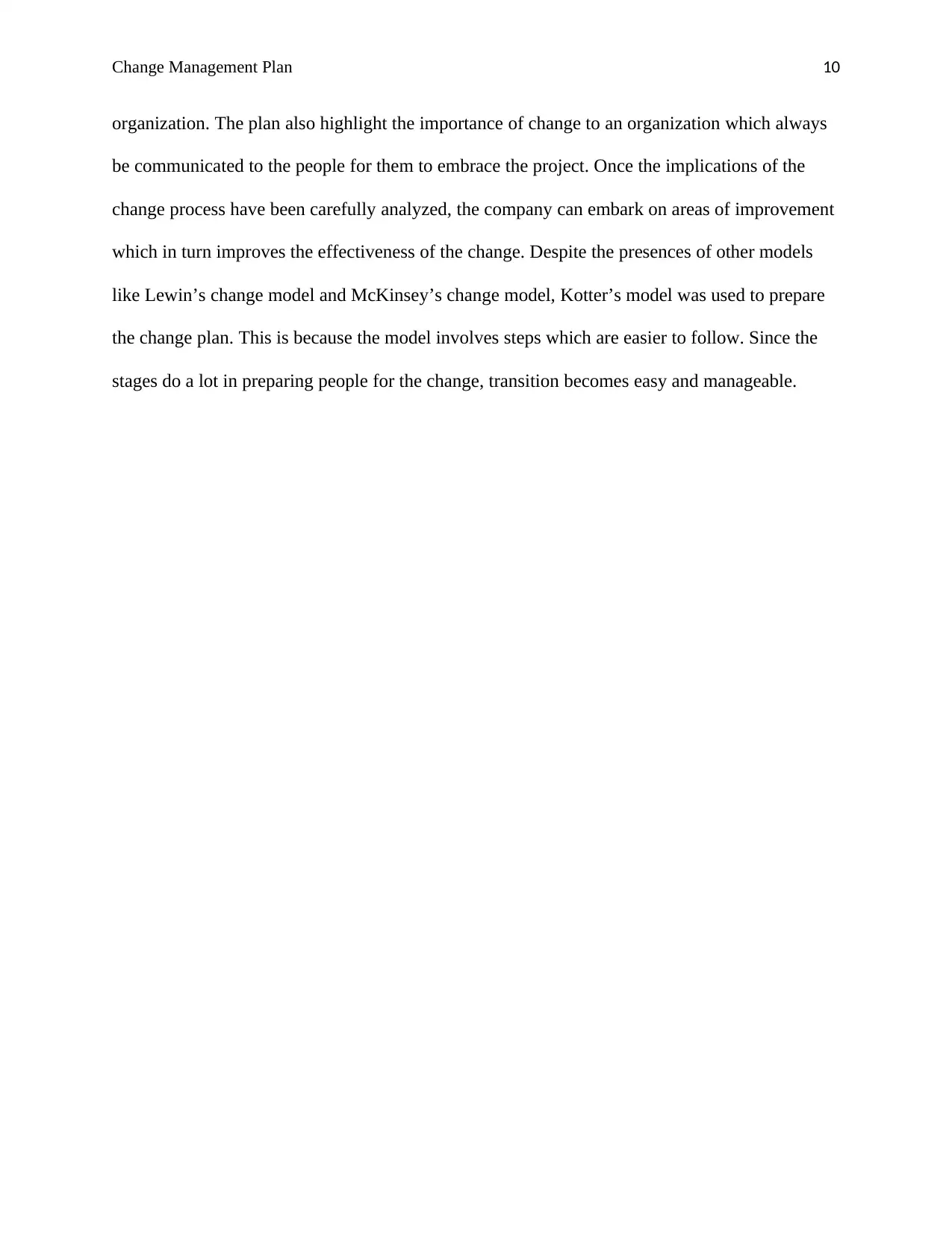
Change Management Plan 10
organization. The plan also highlight the importance of change to an organization which always
be communicated to the people for them to embrace the project. Once the implications of the
change process have been carefully analyzed, the company can embark on areas of improvement
which in turn improves the effectiveness of the change. Despite the presences of other models
like Lewin’s change model and McKinsey’s change model, Kotter’s model was used to prepare
the change plan. This is because the model involves steps which are easier to follow. Since the
stages do a lot in preparing people for the change, transition becomes easy and manageable.
organization. The plan also highlight the importance of change to an organization which always
be communicated to the people for them to embrace the project. Once the implications of the
change process have been carefully analyzed, the company can embark on areas of improvement
which in turn improves the effectiveness of the change. Despite the presences of other models
like Lewin’s change model and McKinsey’s change model, Kotter’s model was used to prepare
the change plan. This is because the model involves steps which are easier to follow. Since the
stages do a lot in preparing people for the change, transition becomes easy and manageable.
Paraphrase This Document
Need a fresh take? Get an instant paraphrase of this document with our AI Paraphraser
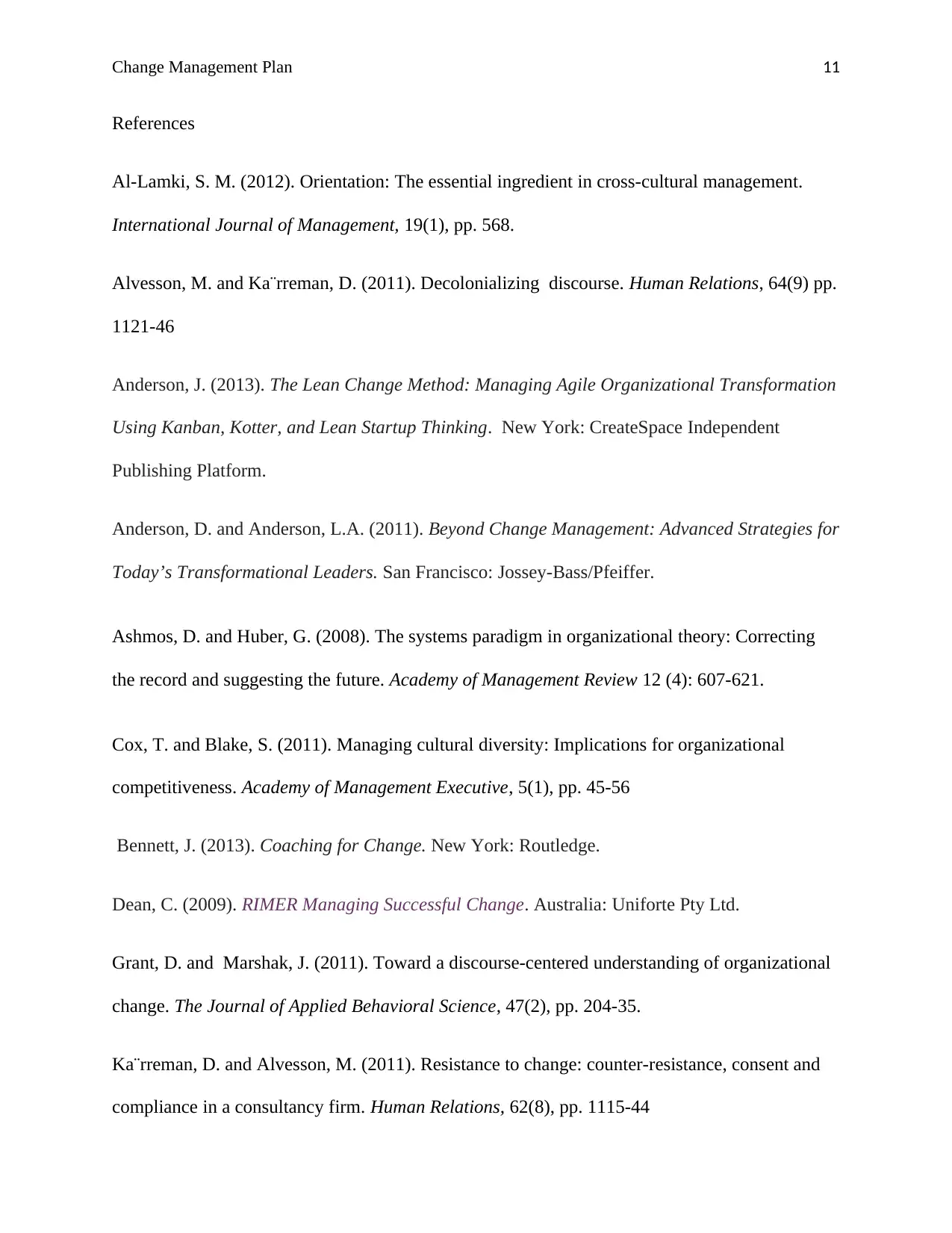
Change Management Plan 11
References
Al-Lamki, S. M. (2012). Orientation: The essential ingredient in cross-cultural management.
International Journal of Management, 19(1), pp. 568.
Alvesson, M. and Ka¨rreman, D. (2011). Decolonializing discourse. Human Relations, 64(9) pp.
1121-46
Anderson, J. (2013). The Lean Change Method: Managing Agile Organizational Transformation
Using Kanban, Kotter, and Lean Startup Thinking. New York: CreateSpace Independent
Publishing Platform.
Anderson, D. and Anderson, L.A. (2011). Beyond Change Management: Advanced Strategies for
Today’s Transformational Leaders. San Francisco: Jossey-Bass/Pfeiffer.
Ashmos, D. and Huber, G. (2008). The systems paradigm in organizational theory: Correcting
the record and suggesting the future. Academy of Management Review 12 (4): 607-621.
Cox, T. and Blake, S. (2011). Managing cultural diversity: Implications for organizational
competitiveness. Academy of Management Executive, 5(1), pp. 45-56
Bennett, J. (2013). Coaching for Change. New York: Routledge.
Dean, C. (2009). RIMER Managing Successful Change. Australia: Uniforte Pty Ltd.
Grant, D. and Marshak, J. (2011). Toward a discourse-centered understanding of organizational
change. The Journal of Applied Behavioral Science, 47(2), pp. 204-35.
Ka¨rreman, D. and Alvesson, M. (2011). Resistance to change: counter-resistance, consent and
compliance in a consultancy firm. Human Relations, 62(8), pp. 1115-44
References
Al-Lamki, S. M. (2012). Orientation: The essential ingredient in cross-cultural management.
International Journal of Management, 19(1), pp. 568.
Alvesson, M. and Ka¨rreman, D. (2011). Decolonializing discourse. Human Relations, 64(9) pp.
1121-46
Anderson, J. (2013). The Lean Change Method: Managing Agile Organizational Transformation
Using Kanban, Kotter, and Lean Startup Thinking. New York: CreateSpace Independent
Publishing Platform.
Anderson, D. and Anderson, L.A. (2011). Beyond Change Management: Advanced Strategies for
Today’s Transformational Leaders. San Francisco: Jossey-Bass/Pfeiffer.
Ashmos, D. and Huber, G. (2008). The systems paradigm in organizational theory: Correcting
the record and suggesting the future. Academy of Management Review 12 (4): 607-621.
Cox, T. and Blake, S. (2011). Managing cultural diversity: Implications for organizational
competitiveness. Academy of Management Executive, 5(1), pp. 45-56
Bennett, J. (2013). Coaching for Change. New York: Routledge.
Dean, C. (2009). RIMER Managing Successful Change. Australia: Uniforte Pty Ltd.
Grant, D. and Marshak, J. (2011). Toward a discourse-centered understanding of organizational
change. The Journal of Applied Behavioral Science, 47(2), pp. 204-35.
Ka¨rreman, D. and Alvesson, M. (2011). Resistance to change: counter-resistance, consent and
compliance in a consultancy firm. Human Relations, 62(8), pp. 1115-44
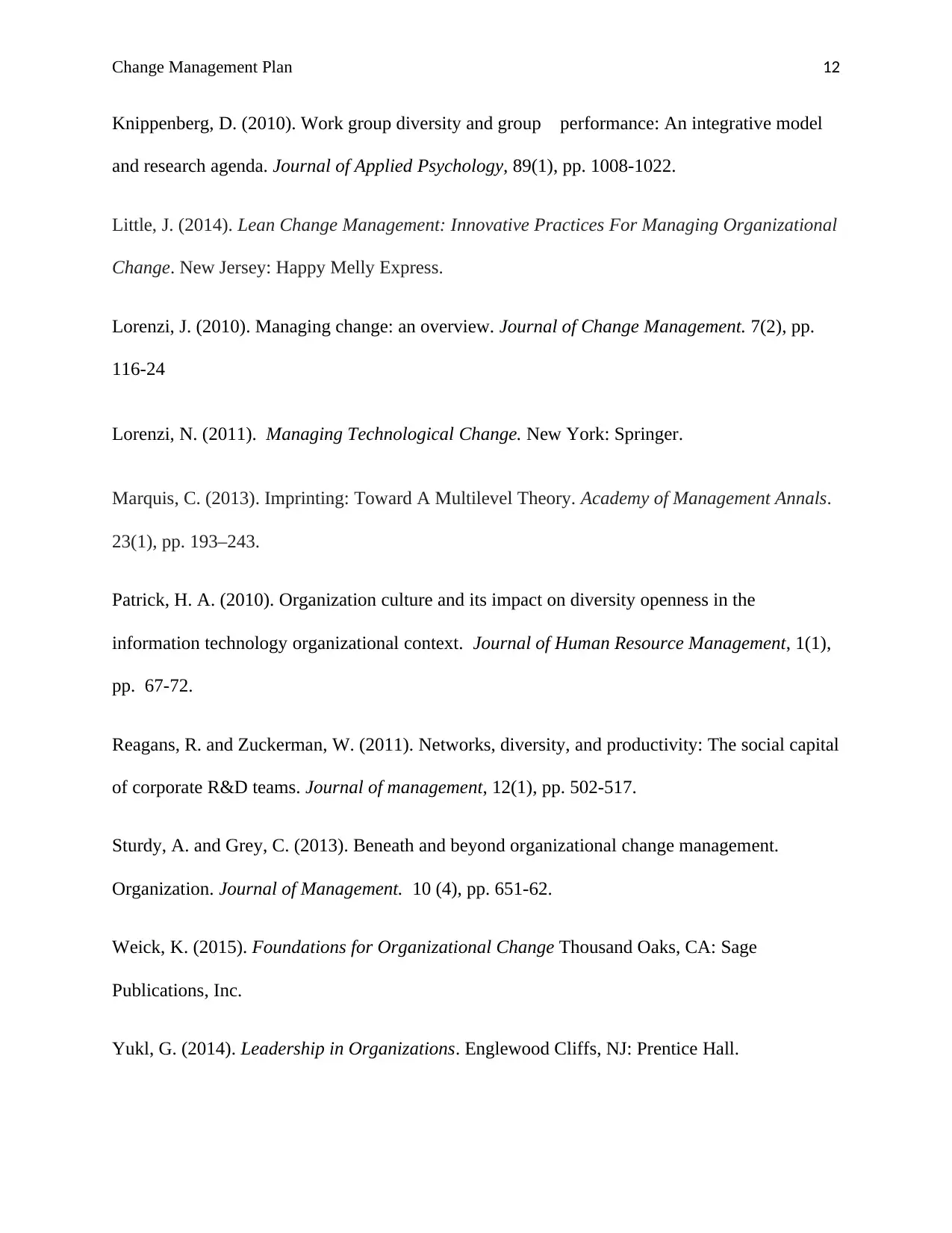
Change Management Plan 12
Knippenberg, D. (2010). Work group diversity and group performance: An integrative model
and research agenda. Journal of Applied Psychology, 89(1), pp. 1008-1022.
Little, J. (2014). Lean Change Management: Innovative Practices For Managing Organizational
Change. New Jersey: Happy Melly Express.
Lorenzi, J. (2010). Managing change: an overview. Journal of Change Management. 7(2), pp.
116-24
Lorenzi, N. (2011). Managing Technological Change. New York: Springer.
Marquis, C. (2013). Imprinting: Toward A Multilevel Theory. Academy of Management Annals.
23(1), pp. 193–243.
Patrick, H. A. (2010). Organization culture and its impact on diversity openness in the
information technology organizational context. Journal of Human Resource Management, 1(1),
pp. 67-72.
Reagans, R. and Zuckerman, W. (2011). Networks, diversity, and productivity: The social capital
of corporate R&D teams. Journal of management, 12(1), pp. 502-517.
Sturdy, A. and Grey, C. (2013). Beneath and beyond organizational change management.
Organization. Journal of Management. 10 (4), pp. 651-62.
Weick, K. (2015). Foundations for Organizational Change Thousand Oaks, CA: Sage
Publications, Inc.
Yukl, G. (2014). Leadership in Organizations. Englewood Cliffs, NJ: Prentice Hall.
Knippenberg, D. (2010). Work group diversity and group performance: An integrative model
and research agenda. Journal of Applied Psychology, 89(1), pp. 1008-1022.
Little, J. (2014). Lean Change Management: Innovative Practices For Managing Organizational
Change. New Jersey: Happy Melly Express.
Lorenzi, J. (2010). Managing change: an overview. Journal of Change Management. 7(2), pp.
116-24
Lorenzi, N. (2011). Managing Technological Change. New York: Springer.
Marquis, C. (2013). Imprinting: Toward A Multilevel Theory. Academy of Management Annals.
23(1), pp. 193–243.
Patrick, H. A. (2010). Organization culture and its impact on diversity openness in the
information technology organizational context. Journal of Human Resource Management, 1(1),
pp. 67-72.
Reagans, R. and Zuckerman, W. (2011). Networks, diversity, and productivity: The social capital
of corporate R&D teams. Journal of management, 12(1), pp. 502-517.
Sturdy, A. and Grey, C. (2013). Beneath and beyond organizational change management.
Organization. Journal of Management. 10 (4), pp. 651-62.
Weick, K. (2015). Foundations for Organizational Change Thousand Oaks, CA: Sage
Publications, Inc.
Yukl, G. (2014). Leadership in Organizations. Englewood Cliffs, NJ: Prentice Hall.
⊘ This is a preview!⊘
Do you want full access?
Subscribe today to unlock all pages.

Trusted by 1+ million students worldwide
1 out of 13
Related Documents
Your All-in-One AI-Powered Toolkit for Academic Success.
+13062052269
info@desklib.com
Available 24*7 on WhatsApp / Email
![[object Object]](/_next/static/media/star-bottom.7253800d.svg)
Unlock your academic potential
Copyright © 2020–2025 A2Z Services. All Rights Reserved. Developed and managed by ZUCOL.





